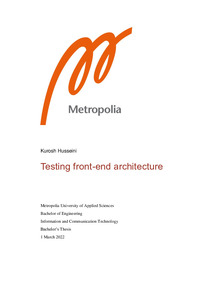Testing front-end architecture
Husseini, Kurosh (2023)
Husseini, Kurosh
2023
All rights reserved. This publication is copyrighted. You may download, display and print it for Your own personal use. Commercial use is prohibited.
Julkaisun pysyvä osoite on
https://urn.fi/URN:NBN:fi:amk-202302252816
https://urn.fi/URN:NBN:fi:amk-202302252816
Tiivistelmä
This thesis aims to emphasize the significance of testing in the software engineering lifecycle. It covers various testing methods and provides best practices for each of them. Additionally, it explains how to develop a test plan and introduces the testing pyramid, which is an effective approach for distributing testing resources. Furthermore, the thesis highlights testing tools that can automate testing methods and how to configure them within a next.js project.
The technical part of this thesis was performed on the Work in Finland website to ensure that the software created was of high quality, performance, and usability. The primary goal was to identify and fix critical bugs that could potentially break the website. The findings indicate that testing should be an integral part of software development from the early stages to minimize costs and ensure high-quality software. Although the benefits of testing may not be immediately visible, they become more evident in the long run.
While this thesis provides an excellent introduction to testing, it only covers some aspects of testing. For instance, it would be advantageous to explore different testing automation tools and compare them to determine which best suits one's needs. Furthermore, it does not include non-functional testing methods such as security, load, stress, and volume testing, which are also crucial. Nevertheless, readers can gain valuable insights into testing methods and understand the risks of not including them in a project.
The significant advantage of this thesis is that it enables readers to quickly acquaint themselves with testing methods and to start testing in a project. In addition, this thesis also provides best practices and tools that can be utilized to automate testing methods.
The technical part of this thesis was performed on the Work in Finland website to ensure that the software created was of high quality, performance, and usability. The primary goal was to identify and fix critical bugs that could potentially break the website. The findings indicate that testing should be an integral part of software development from the early stages to minimize costs and ensure high-quality software. Although the benefits of testing may not be immediately visible, they become more evident in the long run.
While this thesis provides an excellent introduction to testing, it only covers some aspects of testing. For instance, it would be advantageous to explore different testing automation tools and compare them to determine which best suits one's needs. Furthermore, it does not include non-functional testing methods such as security, load, stress, and volume testing, which are also crucial. Nevertheless, readers can gain valuable insights into testing methods and understand the risks of not including them in a project.
The significant advantage of this thesis is that it enables readers to quickly acquaint themselves with testing methods and to start testing in a project. In addition, this thesis also provides best practices and tools that can be utilized to automate testing methods.
